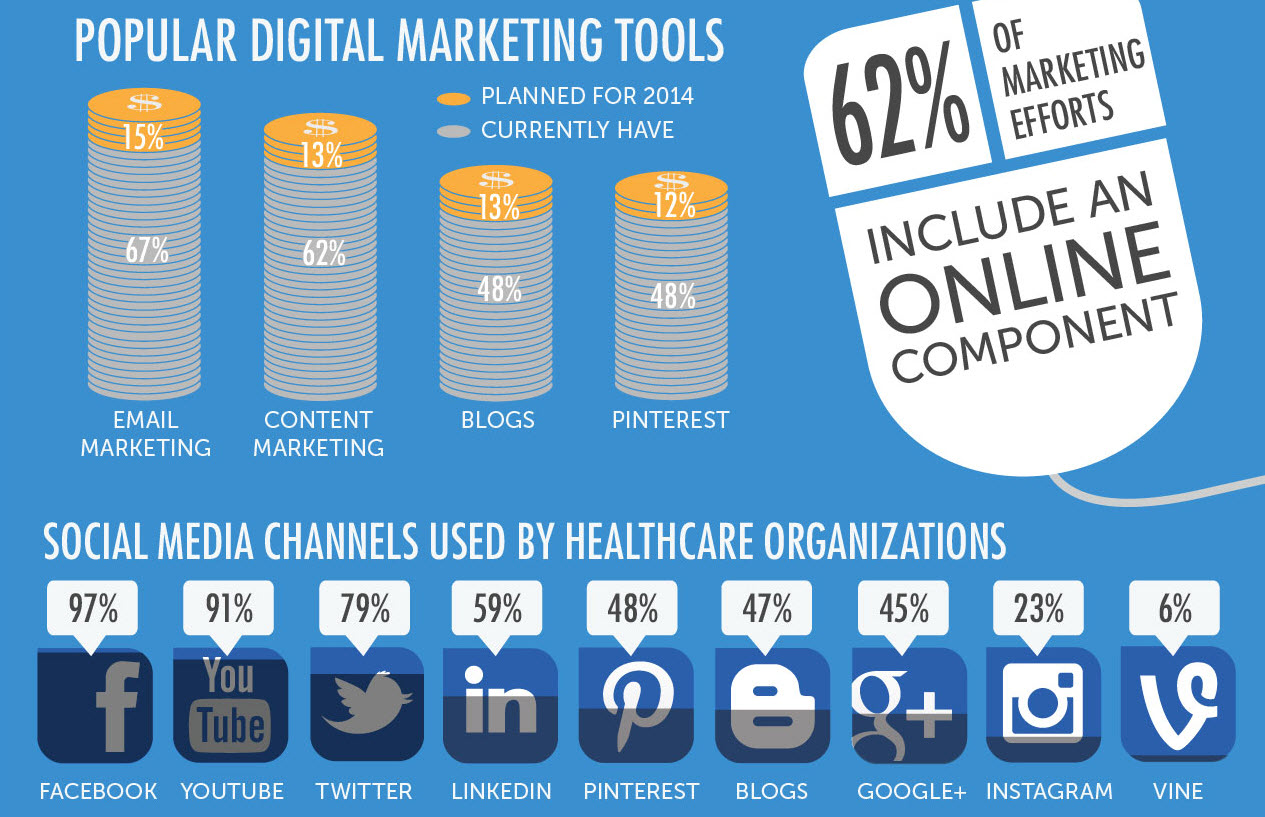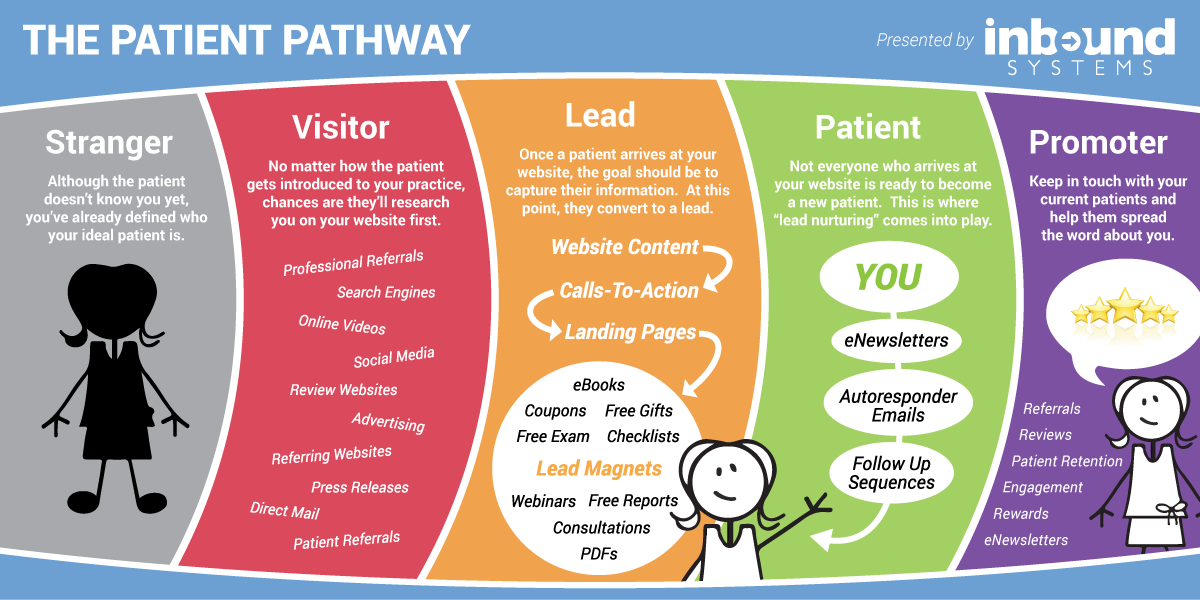Healthcare providers have long relied on patient referrals from other physicians and providers as a means of generating new business. It was effective because outside of referrals the channels for reaching new patients affordably were limited.
With the digital channels available today it’s easier than ever for patients to locate and choose a new provider.
Search engines, social media, review sites and other online channels have put a wealth of information into the hands of patients and have dramatically blurred the lines between network and patient marketing.
Technology and a changing buyer journey is causing healthcare professionals to take a more direct approach to building online awareness and generating qualified leads.
Today, 42% of internet users go online specifically looking for information about healthcare professionals, while 38% use the web to research hospitals and other medical facilities.
With so many consumers going online to find, vet and select healthcare professionals, you have to do more than sell to the provider. You need to adopt a direct-to-patient marketing strategy.
Here’s a simple framework to do that…
Building a Direct-to-Patient Marketing Plan
Direct to patient marketing can be broken down into three fundamental areas – Who, What and Where:
#1: WHO is your target customer – the ideal patient you would like to attract to your practice.
WHERE can your audience be found online – the digital channels where consumers search for information. This will dictate your distribution strategy.
WHAT will grab audience attention – the messaging that will capture attention and prompt people to take action – call, book an appointment, etc.
Let’s look at each of these steps individually.
Step #1: WHO – building your ideal patient profile
Creating a marketing campaign without a clear picture of who you are trying to reach is like hiking the Kokoda Trail without a map.
A persona will help ensure you are serving the right message to the right people, at the right time and place.
It’s a composite sketch of a key segment of your broader audience:

You don’t need to limit yourself to a single persona.
Buffer recommends creating three to five personas to represent the most important segments of your audience. Largest enough to capture the key audience, but not target everyone.
To target everyone is to target no one.
Patient personas should address the following:
- Goals
- Challenges and pain points
- Demographics like age, gender, income, location, etc.
- Channels used to find information online
- Objections in the decision process
HubSpot offers a number of persona examples, and this one from Digital Marketer provides a good starting point:
![]()
Templates may vary slightly, but the essential information is always the same.
Look at this patient persona example to see the similarities:

When creating a personas, you should never make assumptions no matter how well you think you know your audience.
Each persona should be built on research. Here are a few ways to gather details about your target customer:
- Conduct traditional market research. If you have the budget, invest in focus groups or one-on-one interviews with your existing and/or target customers.
- Send out questionnaires. Send questions regarding the main persona sections to your existing customer base. If possible, consider offering a small incentive to customers that complete your survey (eg. local sports dinner, coffee voucher etc).
- Check website analytics. While web and social media analytics platforms can’t tell you who your visitors are, they can provide some valuable insights into the demographics of engaged users.
- Talk to employees. Your customer-facing employees are on the front lines, and will know more about your customers than anyone. Run the questions listed above by them and add their responses to your buyer personas.
- Guess based on past experiences. If you’re short on time or money, you can always answer the questions based on your own observations. This data will have observer bias, but it can provide a decent compass for initial marketing efforts.
Step #2: WHERE – identify your target distribution channels
Part of the persona development phase involves identifying the key channels where prospective patients are consuming information and researching online.
This insight will help guide your distribution strategy. I.e. where you will place ads, share content and ultimately promote your business.
Without this information you’ll spend a lot of time and money marketing in the wrong areas.
For a healthcare professional looking to boost their local online presence, we’ve found the following distribution channels typically drive the most qualified leads:
Local SEO – The Google 3-pack appears in the top spot in 93% of online searches with local intent. What does this means for your practice? If your business doesn’t show up in Google maps when people are searching for the services you provide, you’re missing out on a lot of potential patients:

Google Pay Per Click (PPC) – Ranking in local maps can take months in competitive markets. A good supplemental strategy is to use Google PPC ads to get immediate first visibility for the keywords most valuable to your business. You can get ads in the search results:

And directly in the local map pack:

Build Reviews – 83% of consumers trust the recommendations and reviews of peers when making decisions. Today, you can show up in the search results for all the keywords, but if you don’t have reviews, or worse still have bad reviews, people will avoid your business like the plague:

It’s critical to have a proactive reputation management strategy in place to source and promote positive reviews across the channels visited by your target audience.
Get Listed – You can do more than claim local business listings to expand your visibility. Get your practice listed in relevant industry-specific directories:

Get Social – Direct to patient marketing is about more than just visibility. Patients want to know they can trust you. Social media helps you boost brand awareness and promote the personal side of your practice.
Social media can also be used to educate and attract prospective patients. According to Mediabistro, 41% said social media would impact their choice in a specific doctor, hospital, or medical facility:

Leverage Retargeting – 98% of prospective patients will visit your website and leave without ever converting.
Use retargeting ads to serve targeted messages or offers on Google and social media to people who visited your site without taking action.
Data shared by CMO/Adobe reveals that retargeting can boost ad response by up to 400%, and retargeted consumers are over 70% more likely to convert.
Optimize for Mobile – 52% of smartphone users turn to their mobile devices to get health-related information. Make sure your website is built to provide users with seamless user experience across all devices – mobile, tablet and desktop.
A poor user experience will lead to higher bounce rates (someone visits a page and leaves without viewing any additional content), and lower time on site. These are behavioral signals that tell search engines like Google your site is not the best result for a given search term, which hurts your online rankings.
Step #3: WHAT – messaging resonates with your audience
The last part of your strategy is identifying the content types and messaging that will engaged your audience, and get them to take action – call, book an appointment etc.
But, not all messaging is created equal.
A key component in this step involves mapping content to the patient journey. You need to understand the information needs of patients at the top, middle and bottom of the funnel.

This is a simple tool that tells the customer’s story over time. The end goal is to move the patient from problem-aware down the funnel to paying customer.
Once you understand informational needs at each stage, you can start to develop and plot content within each one. This will ensure your content strategy is driving prospective patients down the funnel – driving awareness, answering questions, building trust, overcoming objections, and positioning your business as the top service option.
There’s a lot of different content types and topics that can be used within each stage of the patient journey:
- Blogs
- Slide decks
- Video
- Case studies
- Landing pages
- ebooks
- Surveys/ quizzes
The personas will help determine which ones make the most sense for your business.
It’s worth emphasizing not to create content for the sake of creating content. Every asset should have a purpose and place within your ideal patient’s journey:

Execute, Measure and Refine
The three steps outlined above make up the core of your direct-to-patient marketing strategy.
First, you need to understand who your ideal patient is, so you can target where they consume information online. Finally, you need to focus on what information will position your business the best at each stage of the patient journey.
Once the strategy is in place, set some KPIs to ensure you are tracking the metrics most important to the growth of your business – organic traffic, leads, cost-per-lead and lead-to-patient ratios.
This will allow you to invest the marketing dollars in the channels delivering a positive ROI for your business.







